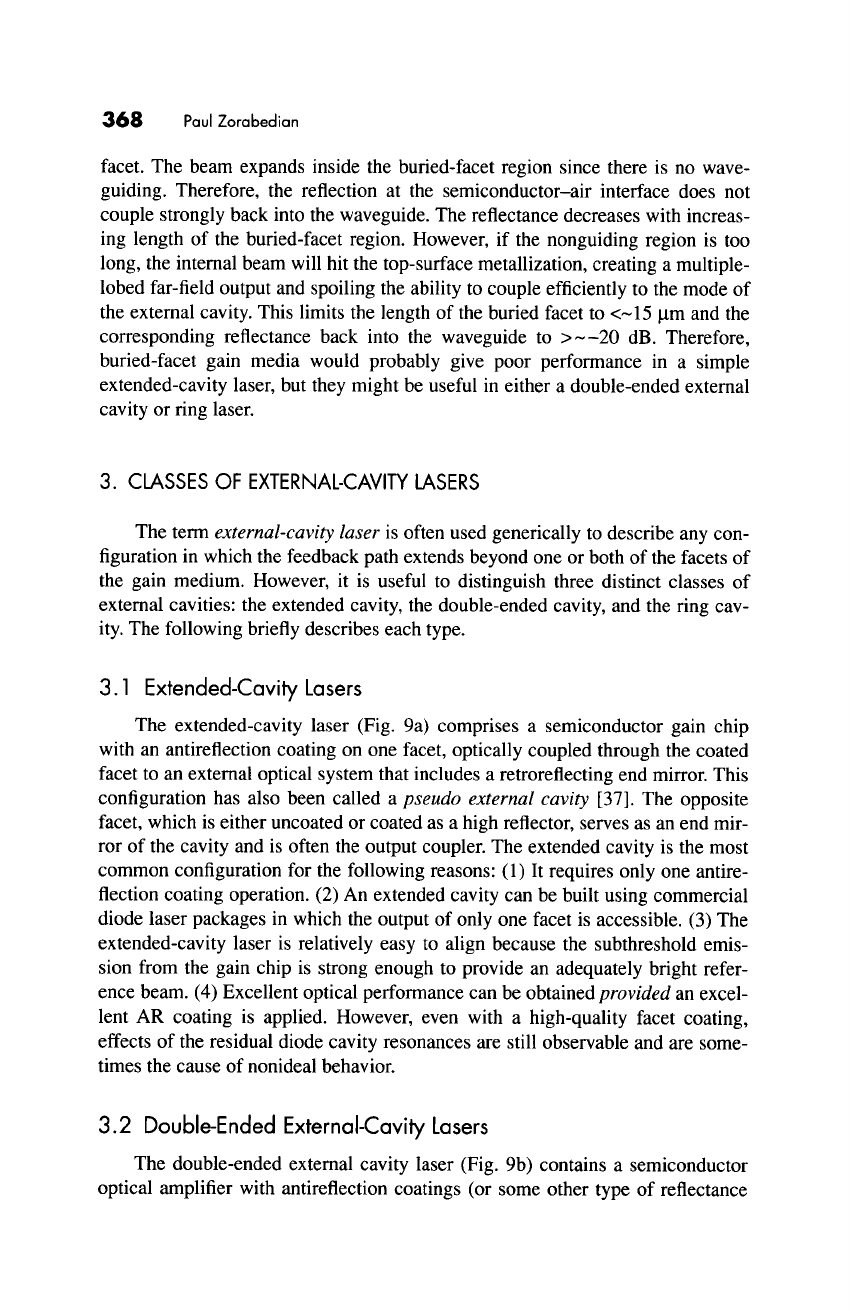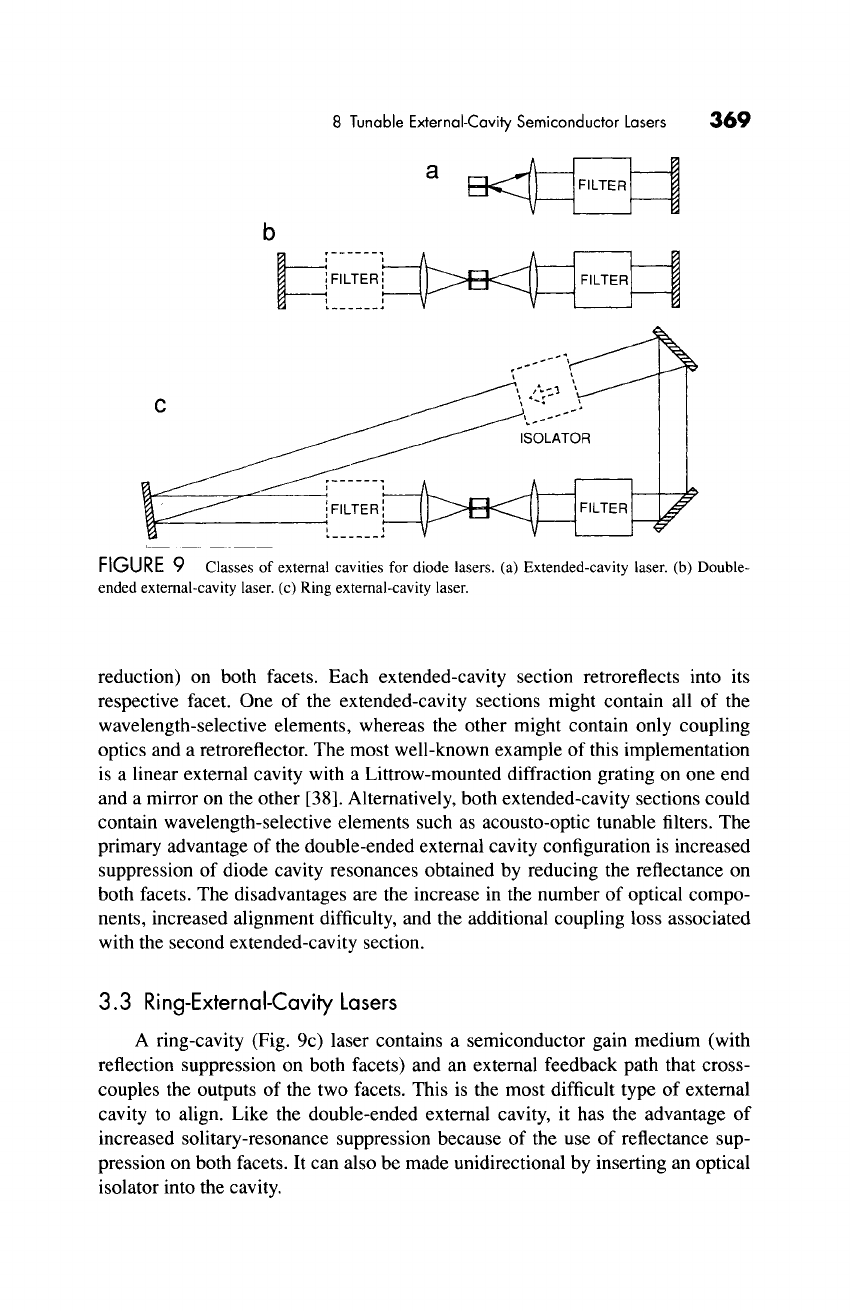
368 Paul Zorabedian
facet. The beam expands inside the buried-facet region since there is no wave-
guiding. Therefore, the reflection at the semiconductor-air interface does not
couple strongly back into the waveguide. The reflectance decreases with increas-
ing length of the buried-facet region. However, if the nonguiding region is too
long, the internal beam will hit the top-surface metallization, creating a multiple-
lobed far-field output and spoiling the ability to couple efficiently to the mode of
the external cavity. This limits the length of the buried facet to <-15 ~tm and the
corresponding reflectance back into the waveguide to >--20 dB. Therefore,
buried-facet gain media would probably give poor performance in a simple
extended-cavity laser, but they might be useful in either a double-ended external
cavity or ring laser.
3. CLASSES OF EXTERNAL-CAVITY LASERS
The term external-cavity laser is often used generically to describe any con-
figuration in which the feedback path extends beyond one or both of the facets of
the gain medium. However, it is useful to distinguish three distinct classes of
external cavities: the extended cavity, the double-ended cavity, and the ring cav-
ity. The following briefly describes each type.
3.1 Extended-Cavity Lasers
The extended-cavity laser (Fig. 9a) comprises a semiconductor gain chip
with an antireflection coating on one facet, optically coupled through the coated
facet to an external optical system that includes a retroreflecting end mirror. This
configuration has also been called a pseudo external cavity [37]. The opposite
facet, which is either uncoated or coated as a high reflector, serves as an end mir-
ror of the cavity and is often the output coupler. The extended cavity is the most
common configuration for the following reasons: (1) It requires only one antire-
flection coating operation. (2) An extended cavity can be built using commercial
diode laser packages in which the output of only one facet is accessible. (3) The
extended-cavity laser is relatively easy to align because the subthreshold emis-
sion from the gain chip is strong enough to provide an adequately bright refer-
ence beam. (4) Excellent optical performance can be obtained provided an excel-
lent AR coating is applied. However, even with a high-quality facet coating,
effects of the residual diode cavity resonances are still observable and are some-
times the cause of nonideal behavior.
3.2
Double-Ended External-Cavity
Lasers
The double-ended external cavity laser (Fig. 9b) contains a semiconductor
optical amplifier with antireflection coatings (or some other type of reflectance

8 Tunable External-Cavity Semiconductor Lasers 369
a
~: -=!FILTER
FILTER i FILTER
2T!
g " i ....... V- W I I ~,"
FIGURE 9
Classes of external cavities for diode lasers. (a) Extended-cavity laser. (b) Double-
ended external-cavity laser. (c) Ring external-cavity laser.
reduction) on both facets. Each extended-cavity section retroreflects into its
respective facet. One of the extended-cavity sections might contain all of the
wavelength-selective elements, whereas the other might contain only coupling
optics and a retroreflector. The most well-known example of this implementation
is a linear external cavity with a Littrow-mounted diffraction grating on one end
and a mirror on the other [38]. Alternatively, both extended-cavity sections could
contain wavelength-selective elements such as acousto-optic tunable filters. The
primary advantage of the double-ended external cavity configuration is increased
suppression of diode cavity resonances obtained by reducing the reflectance on
both facets. The disadvantages are the increase in the number of optical compo-
nents, increased alignment difficulty, and the additional coupling loss associated
with the second extended-cavity section.
3.3 Ring-External-Cavity
Lasers
A ring-cavity (Fig. 9c) laser contains a semiconductor gain medium (with
reflection suppression on both facets) and an external feedback path that cross-
couples the outputs of the two facets. This is the most difficult type of external
cavity to align. Like the double-ended external cavity, it has the advantage of
increased solitary-resonance suppression because of the use of reflectance sup-
pression on both facets. It can also be made unidirectional by inserting an optical
isolator into the cavity.
Get Tunable Lasers Handbook now with the O’Reilly learning platform.
O’Reilly members experience books, live events, courses curated by job role, and more from O’Reilly and nearly 200 top publishers.

